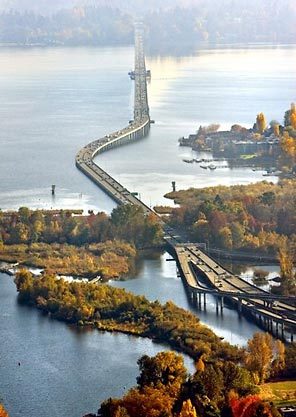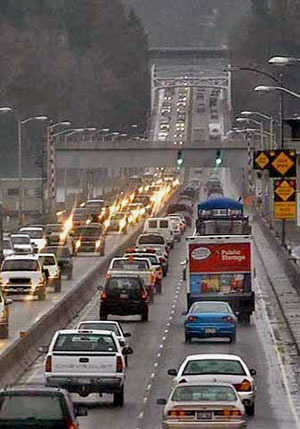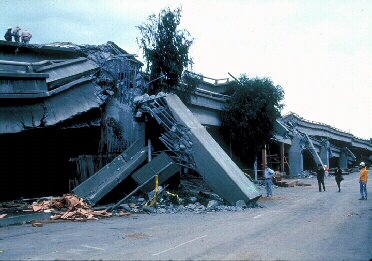From Clevelamd BRT website 3/7/04
Rapid Transit System
The Need for Better Bus Service
Modern metropolitan areas depend on transit to provide transportation connections to build strong economies and communities. Excessive dependence on automobiles has contributed to sprawling patterns of urban development that clog the roadway network with congestion, pollute the air, blight the landscape, and undermine the character of neighborhoods. Buses provide attractive and effective alternatives to automobiles, and flexible, low-cost alternatives to rail, reaching into central cities, neighborhoods, and suburbs to meet the mobility needs of millions of people.
Conceived as an integrated, well-defined system, Bus Rapid Transit can provide significantly faster operating speeds and greater service reliability than conventional bus operations, matching the quality of rail when implemented in appropriate settings.

The Bus Rapid Transit Initiative
The Federal Transit Administration is launching the Bus Rapid Transit Initiative to improve the speed, reliability, and convenience of bus service, to enhance the mobility and access needed for thriving communities, and to promote a healthy environment. Central to the Initiative is a Demonstration Program introducing Bus Rapid Transit to the United States at several competitively chosen locations, backed by technical support from the FTA.
Features of Bus Rapid Transit
Several United States sites, including Los Angeles, Cleveland, Boston, Eugene and the Dulles corridor in northern Virginia, are now studying the possibility of implementing bus Rapid Transit facilities. Coordinated improvements in infrastructure, operations, and technology are the foundation for Bus Rapid Transit, and include some or all of the following features:
Bus lanes: A lane on a city street or an urban arterial is reserved for the exclusive or near-exclusive use of buses.
Bus streets and busways: A bus street or transit mall is created by dedicating all lanes of a city street for the exclusive use of buses.
Bus signal preference and preemption: Preferential treatment of buses at intersections can involve advancing or extending green time at signalized intersections upon detection of an approaching bus.
Traffic engineering improvements: Low-cost infrastructure improvements supporting Bus Rapid Transit, such as bus turnouts, bus boarding islands, and curb realignment that allow buses to bypass congested segments of the roadway network, can produce major improvements in speed and reliability.
Faster boarding: Innovations in fare collection can speed the boarding process through payment of fares upon entry to enclosed boarding areas, the use of smart cards, or a self-service horn system in which evidence of prior fare payments is spot-checked while passengers are onboard the bus. Physical access to buses can be made both quicker and easier through changes in bus or platform design to provide level boarding.
Integrated planning: Integrating land use planning with transit development assures that transit service is available where needed and that there is a ready demand for it. Supportive land use policy includes zoning for high density residential and commercial building along transit routes.
Other BRT Systems
Curitiba Experience in Bus Rapid Transit
The bus system of Curitiba, a rapidly growing city of 2.3 million people in southern Brazil, exemplifies a model Bus Rapid Transit system, which plays a large part in making this a livable city. Curitiba has one of the most heavily used, yet low-cost, transit systems in the world. It offers many of the features of a subway system -- vehicle movements unimpeded by traffic signals and congestion, fare collection prior to boarding, quick passenger loading and unloading, efficient, reliable service -- but it is above ground and visible.
Fast city street bus operations are the result of linking urban planning and transit development to promote high density residential and commercial development along the major transit routes. The system evolved incrementally as innovative low-cost and low-tech options for new services and features were chosen over more expensive alternatives at each stage.

Curitiba's bus system is composed of a hierarchical system that includes a range of services from small feeder minibuses to conventional buses. The backbone of the bus system is composed of express buses operating on five main arteries leading into the city center. This backbone, aptly described as Bus Rapid Transit, is characterized by the following features:
- Integrated planning
- Exclusive bus lanes
- Signal priority for buses
- Pre-boarding fare collection
- Level bus boarding from raised platforms in tube stations
- Free transfers between lines (single entry)
- Large capacity articulated and bi-articulated wide-door buses
- Overlapping system of bus services
Even with one automobile for every three people, one of the highest automobile ownership rates in Brazil, around two thirds of Curitiba's inhabitants use transit daily to commute to work. Curitiba enjoys one of the lowest rates of ambient air pollution in Brazil, and uses about 30 percent less fuel per capita when compared to other Brazilian cities.









